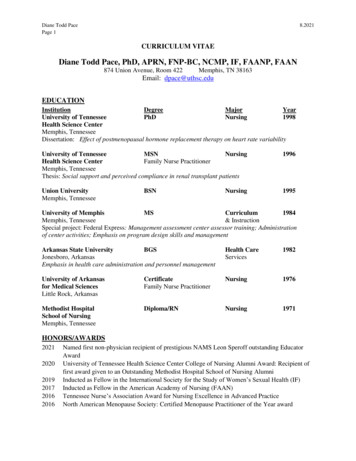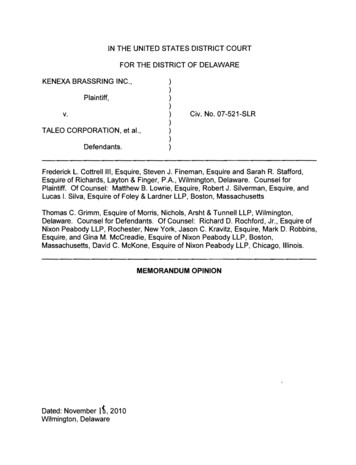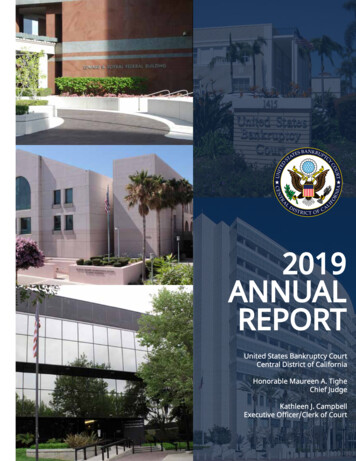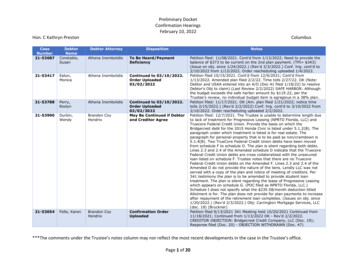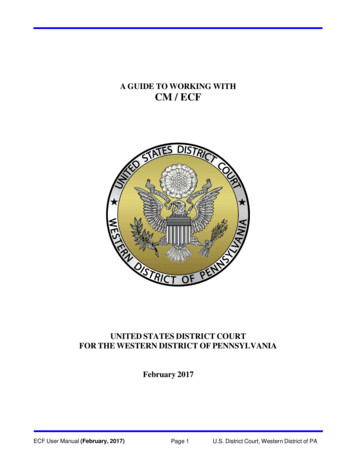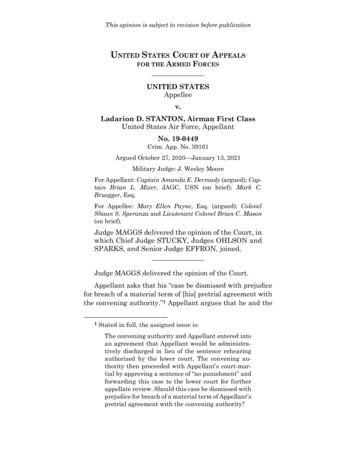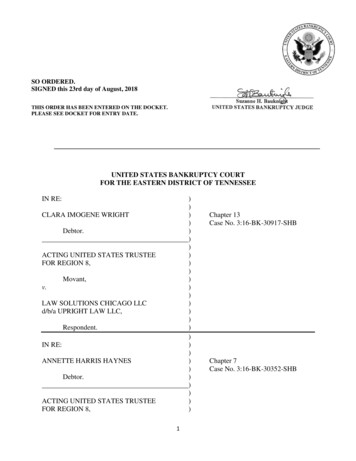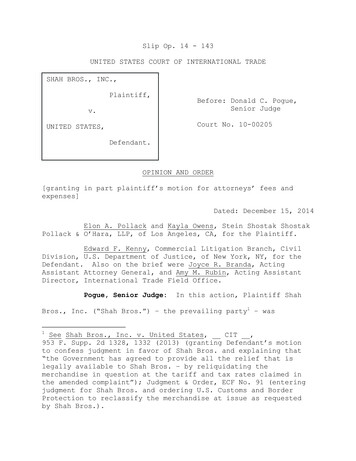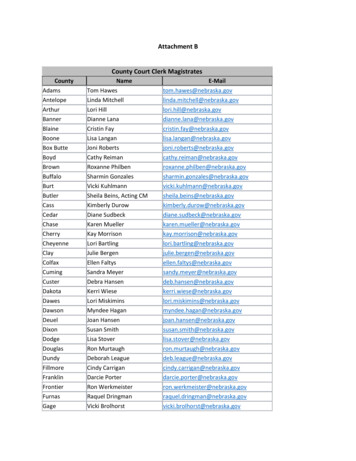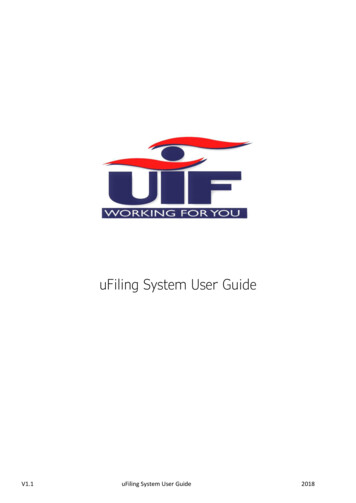
Transcription
Benefits Overview3
Contents4 Defining Benefit Eligibility12 Taking the Long ViewStaying Healthy612 Federal Judiciary Long-TermCare Insurance Program6 Health Insurance7 Dental and Vision Insurance8 Securing a Sound Retirement8 Federal EmployeesRetirement System9 Thrift Savings Plan13 Federal Long-Term CareInsurance Program19 Helping with IssuesLarge and Small19 Employee AssistanceProgram (EAP)20 Finding Time to Recharge14 Helping Reduce What You Pay20 Annual Leave Program14 Premium Payment Plan20 Government Holidays14 Health Care ReimbursementAccount21 Changing Your Choices15 Dependent CareReimbursement Account10 Protecting Against the Unexpected 16 Professional LiabilityInsurance Reimbursement10 Life InsuranceProgram11 Family Medical LeaveAct (FMLA)11 Sick Leave17 Saving More Along the Way11 Leave Transfer Program17 Commuter Benefit Program22 Quick Reference23 BeneFit Checklist forNewly Hired Employees11 Disability Retirement4F e d e r a lJu d i c i a ryB e n e f i t sP r o g r a m
BeneFit for Life Your Federal Judiciary Benefits Program providesa wide range of benefits and choices so you cancreate a package to “BeneFit” your individual needs. On day one and throughout your career, beinginformed about your Judiciary benefits is highlyimportant, and there are useful resources availableto help you learn more, compare choices, and makedecisions that truly fit your personal situation.This booklet is designed to give you an overviewof all your Federal Judiciary benefits along with a“BeneFit Checklist” and Quick Reference to helpyou keep track of important deadlines so you cantake full advantage of your benefits right from thestart and every step along the way.For Newly Hired Judiciary Employees—Keep in mindthat the enrollment clock starts ticking on your firstday of employment, and there are certain benefitsthat require you take action sooner rather than later.For All Judiciary Employees—Understanding the insand outs of your benefits and keeping track of howthey are performing throughout the year is key tomaking the most of your benefit program.Note: Eligibility for certain benefits depends on yourappointment type. Refer to the charts on pages 4-5 orcheck with the Benefits Coordinator at your locationfor details.3
Defining BenefitEligibilityEligibility for certain benefits depends onyour appointment type, with a specificbenefit package for law clerks. Referto the charts on these two pages for ageneral overview.Type of AppointmentExceptedAppointmentNo established time limitLeaveSocial Security& Thrift SavingsPlan (TSP) X1 X4X4X4X4X4X4X4X4 Temporary–1 year or lessNTE 90 days or lessNTE more than 90 daysTemporary–More than 1 yearNTE more than 1 year 1 Eligible for BenefitAnother type of appointment in the Judiciary is When Actually Employed (WAE),and is used when the employee has nopre-determined work schedule. WAEemployees can serve on permanent ortemporary appointments; however, regardless of the type of appointment they’re on,WAE employees are generally excludedfrom insurance, retirement, TSP, andsupplemental benefits. The only exceptionto this rule is when an employee whoseintermittent appointment follows, withno break in service, a position in whichthe employee held such benefits, and towhich the employee is expected to return.1X Not Eligible for BenefitI f the duration of the appointment is less than 90 days, the employee will only earn sick leave. Ifthe appointment is extended beyond 90 days, the employee will earn annual leave retroactivelyto the start of the appointment for each full pay period served. If the temporary duration of theappointment is 90 days to 1 year or less, the employee will earn sick and annual leave startingthe first leave period in which a complete biweekly tour of duty is served.The Federal Insurance Contributions Act (FICA) tax has two components: (1) Social Security; and(2) Medicare. Employees covered by the Federal Employees Retirement System (FERS) or the CivilService Retirement System (CSRS) – Offset, are covered by both Social Security and Medicare.Employees covered by CSRS are covered only by Medicare.2 Insurance programs offered include Health (Federal Employees Health Benefits Program), Dental/Vision (Federal Employees Dental and Vision Insurance Program), and Life (Federal Employees’Group Life Insurance Program). If the employee is eligible for these benefits, each benefit is optional.Enrollment in any one of them is not required in order to elect any other insurance benefit.3 Insurance, Retirement, Supplemental Benefits, and TSP are available only if transferring without abreak in service from a previously covered position. Generally, you are eligible to make contributions to a Reimbursement Account if you are an active employee who is eligible to participate in theFederal Employees Health Benefits (FEHB) Program. You do not have to be enrolled in the FEHBProgram, just eligible to enroll.4 Supplemental benefits include health and dependent care reimbursement accounts, commuterbenefits, Transportation Subsidy Program, and long-term care. If the employee is eligible for thesebenefits, each benefit is optional. Enrollment in any one of them is not required in order to electany other supplemental benefit.5 Additional information regarding WAEappointments can be found in the HumanResources Manual.4F e d e r a lJu d i c i a ryB e n e f i t sP r o g r a m
Defining Benefit Eligibility continuedLaw ClerksLaw ClerksType of Law ClerkTerm ChambersLimited to 4 years or lessCareer ChambersGenerally more than 4 yearsPermanent CourtStaff–No NTE Date(e.g., Pro Se, Death Penalty,Bankruptcy Appellate Panel)CertificationForm to UseLeaveSocial Security& Thrift SavingsPlan (TSP)AO 75AX1 X5 X5AO 75CX1 AO 75EX1 AO 75DAO 75EX 1, 2X 1, 2 X5X5X5X5X5X5X5X5AO 75DAO 75EX1X1 X5 X5Temporary–1 year or lessChambersCourt StaffTemporary–More than 1 yearChambersCourt Staff Eligible for BenefitX Not Eligible for Benefit aw clerks are exempt from the provisions of 5 U.S.C. chapter 63, subchapter 1 (“Annual and SickLLeave,” formerly referred to as the “Leave Act”), unless specifically included by their appointingjudge or local rule of court under authority of 28 U.S.C. §§ 712, 752, 156(a), 634(c), and 794. Thisexemption includes annual leave, sick leave and home leave; and by reference, family and medicalleave, voluntary leave transfer, and emergency leave. Any law clerk who is exempt from 5 U.S.C.,chapter 63, subchapter 1 remains eligible for court leave, military leave, bone marrow and organdonor leave, and time-off to attend the funeral of an immediate relative who died in military combat.12I f the temporary law clerk is covered by annual sick leave provisions and the duration of theappointment is less than 90 days, the incumbent will only earn sick leave. If the appointment isextended beyond 90 days, the incumbent will earn annual leave retroactively to the start of theappointment for each full pay period served. If the temporary law clerk is covered by annual andsick leave provisions and the duration of the appointment is 90 days to 1 year less, the incumbentwill earn annual and sick leave starting the first leave period in which a complete biweekly tour ofduty is served.3 e Federal Insurance Contributions Act (FICA) tax has two components: (1) Social Security; andTh(2) Medicare. Employees covered by the Federal Employees Retirement System (FERS) or the CivilService Retirement System (CSRS) – Offset, are covered by both Social Security and Medicare.Employees covered by CSRS are covered only by Medicare. Court Staff Law Clerks include pro se,death penalty, and bankruptcy appellatepanel law clerks.For all the details about your FederalJudiciary benefits, go to: J-Net Benefits pages http://judiciary.adp.com www.opm.gov Insuranceprograms offered include Health (Federal Employees Health Benefits Program), Dental/Vision (Federal Employees Dental and Vision Insurance Program), and Life (Federal Employees’Group Life Insurance Program). If the law clerk is eligible for these benefits, each benefit is optional.Enrollment in any one of them is not required in order to elect any other insurance benefit.4 Insurance, Retirement, Supplemental Benefits, and TSP are available only if transferring without abreak in service from a previously covered position. Generally, you are eligible to make contributionsto a Reimbursement Account if you are an active employee who is eligible to participate in theFederal Employees Health Benefits (FEHB) Program. You do not have to be enrolled in the FEHBProgram, just eligible to enroll.5 Supplemental benefits include health and dependent care reimbursement accounts, commuterbenefits, Transportation Subsidy Program, and long-term care. If the employee is eligible for thesebenefits, each benefit is optional. Enrollment in any one of them is not required in order to elect anyother supplemental benefit.6 5
Staying HealthyIt’s true that you can’t put a price tag ongood health, and the Federal Judiciaryprovides benefits to help you and yourfamily stay healthy and keep fit.60Health InsuranceENROLL WITHINfirst 60 DAYS OFEMPLOYMENTProgram NameWhat It ProvidesYou can change yourhealth, dental, andvision coverage onlyYourself only or yourself and eligiblefamily membersHealth Plan Choices F ee For Service (FFS) H ealth Maintenance Organization (HMO) H igh Deductible Health Plan (HDHP) C onsumer-Driven Health Plan (CDHP)experience a qualifyinglife event (see page 21).Provider ChoicesThe amount you payfor health, dental,Your Costand vision benefitsis withheld from yourbi-weekly or monthlyFind Out Morepaycheck on apre-tax basis.Plan Comparison ToolsHow to EnrollDeadlineWhen is it Effective?6Comprehensive medical benefits includinghospitalization, surgery, doctor’s office visits,preventive care, and prescription drugsWho Can You Coverduring annual OpenSeason or if youFederal Employees Health Benefits (FEHB)Based on the state in which you liveYou pay approximately 30% of the total premiumbased on the plan you choose (More if you areemployed on a part time basis) J -Net Benefits pages: Health Insurance O PM website at www.opm.govOn the OPM website and atwww.plansmartchoice.comJudiciary Benefits Center website athttp://judiciary.adp.comEnroll within the first 60 days of employmentThe first day of the first pay period followingthe date your election is received by the JudiciaryBenefits CenterF e d e r a lJu d i c i a ryB e n e f i t sP r o g r a m
60Dental and Vision InsuranceENROLL WITHINfirst 60 DAYS OFEMPLOYMENTNote that you can enrollProgram NameWhat DentalInsurance ProvidesCoverage for most types of dental work, includingcleaning, x-rays, crowns, and, in some cases,orthodontic services for dependents under age 19What VisionInsurance ProvidesCoverage for eye exams, glasses, and contact lensesWho Can You CoverYourself only; yourself plus one eligible familymember; or, yourself and all eligible family membersDental Plan ChoicesFour national plans and three regional plansVision Plan ChoicesThree national plansin dental insurance orvision insurance, or inboth. Who you coverunder dental or visiondoes not have to matchwho you cover underhealth insurance.Federal Employees Dental and Vision InsuranceProgram (FEDVIP)Provider ChoicesYour CostFind Out MorePlan Comparison ToolsHow to EnrollDeadlineWhen is it Effective?Based on the state in which you liveYou pay 100% of the premium based on the planyou choose J -Net Benefits pages: Dental/Vision Insurance O PM website at www.opm.gov B ENEFEDS website at www.benefeds.comOn the OPM website and at www.plansmartchoice.comBENEFEDS website at www.benefeds.comEnroll within the first 60 days of employmentThe first day of the first pay period following the dateyour election is received by BENEFEDSSome medical plans under the FEHB offer “buy ups” for dental and/or vision coverage—that are not part of FEDVIP—for their members, and depending on the plan, even nonmembers. There are also carriers outside of both FEHB and FEDVIP that sometimes offercoverage options to federal employees. Payment for coverage outside of FEHB and FEDVIPis usually made directly to these carriers and in one lump sum payment. All questions forthis type of coverage are also directed to the carriers.7
Securing a SoundRetirementWhether your retirement is rightaround the corner or years down theroad, retirement benefits and a savingsplan are available to help you build asolid financial future.AutomaticFederal Employees Retirement Systemcoverage isautomatic uponEMPLOYMENTProgram NameWhat It IsA retirement plan with three components—FERSBasic Benefit, Social Security, and Thrift SavingsPlan (TSP)CoverageFederal civilian employees first hired after12/31/1983 are automatically covered under FERS(see eligibility charts on pages 4 and 5)If you are covered underthe Civil ServiceRetirement System(CSRS) or the CSRSOffset, please refer toWhat It ProvidesUpon retirement: F ERS Basic Benefit—a monthly annuity basedon years of service and high-3 average salary S ocial Security—a monthly benefit beginningat age 62 (or later if you choose) T SP—various income withdrawal options fromyour account such as single payment, monthlypayments, annuity purchase, or a combinationof optionsYour Cost Y ou contribute 7% of your salary to retirementbenefits, which is split:-E OD before 2013o FERS Basic Benefit: 0.8%o Social Security: Current national percentage- EOD after 2012o FERS Basic Benefit: 3.1%o Social Security: Current national percentage Y ou decide how much to contribute to TSPKey PointTo receive a full FERS Basic Benefit, you needto meet specific age and service requirementsthe information on theJ-Net Benefits pagesand the OPM website.If eligible, a FERSAnnuity Supplement ispaid to you (in additionto your Basic Benefit)until you reach age 62and are eligible forSocial Security.FERS Annuity FormulaFind Out More8Federal Employees Retirement System (FERS)www.opm.gov/retire J -Net Benefits pages: Retirement O PM website at www.opm.govF e d e r a lJu d i c i a ryB e n e f i t sP r o g r a m
AutomaticThrift Savings PlanENROLLMENT isautomatic uponEMPLOYMENTProgram NameWhat It IsIt is your responsibilityto set your financialgoals for retirement, Before-tax contributions or after taxcontributions Tax-deferred investment earnings A diversified choice of investment options Federal Judiciary contributions of 1% of basicannual pay, whether or not you elect to contribute Matching contributions—dollar for dollar on thefirst 3% of pay you contribute and fifty cents perdollar on the next 2%Your Cost As a new hire, you will be automatically enrolledat a contribution rate of 3%. You can elect to contribute a different percentage or a specific dollaramount up to the IRC maximum deferral limit,or waive contributions altogether.TSP plays an importantrole from your firstday of employment on.No matter your ageor the stage in yourKey Pointsfor you to plan andsave for your retirement now. The FederalJudiciary provides tools At age 50 or older, you can elect to makecatch-up contributions in addition to yourregular contributions You can change your contribution amountsand fund allocations at any timeFind Out More J-Net Benefits pages: Thrift Savings Plan TSP website at www.tsp.govTSP and resources to helpyou accomplish both.A retirement savings and investment plan—similar to a 401(k)—to which you and youragency make contributionsWhat It Providesand saving through thecareer, it is importantThrift Savings Plan (TSP)How to Make ElectionsMake, change, or stop elections by completingForm TSP-1 and submit it to your local HRrepresentative. (Watch for electronic electionsvia Employee Self Service in the future.)“Your Retirement Lifeline” is an easy-to-use resource to help you plan for your retirement.Designed specifically for Federal Judiciary employees, it provides the information youneed to get informed and organized around financial planning for retirement. The“Retirement Lifeline” is available on the J-Net Retirement Benefits page.9
Protecting Againstthe UnexpectedFor those times when life deliversthe unexpected—an illness, accident,injury, etc.—there are several Judiciarybenefit programs available to providepeace of mind and financial protectionfor you and your family.60Life InsuranceENROLL WITHINfirst 60 DAYS OFEMPLOYMENTProgram NameWhat It ProvidesYou are automaticallyWho You Can Covercovered by basic lifeinsurance on your firstBasic Life Insuranceday of employment. Youcan waive this coverageat any time. After yourinitial enrollment period,Optional Life Insuranceyou may only increasecoverage during aqualifying life event;upon approval afterhaving a medicalexamination; or in rareinstances, during a lifeinsurance open season.Yourself, your spouse, and your eligible dependent children C overage is provided automatically A mount is your salary rounded to the nearestthousand, plus two thousand E xtra benefit for employees under age 45 at noadditional costYou can elect optional insurance S tandard Option A: Amount is 10,000 Additional Option B: Amount is equal to one, two,three, four, or five times your annual rate of basic pay(after rounding up to the next even 1,000) F amily Option C:–Y our spouse: Amount is 5X multiplesof 5,000 up to a maximum of 25,000–Y our children: Amount is 5X multiplesof 2,500 up to a maximum of 12,500 G overnment pays one-third the cost of basic lifeand you pay two-thirds Y ou pay the full cost of optional lifeKey Points You must maintain basic life to carry optional life Accidental Death and Dismemberment (AD&D)coverage is an automatic part of basic life andOption A insuranceto the FEGLI Programare expected in thenear future.Find Out More10Term life insurance at group ratesYour CostPlease note thatsignificant changesFederal Employees’ Group Life Insurance (FEGLI) J -Net Benefits pages: Life Insurance O PM website at www.opm.govFLifee dInsurancee r a l continuedJ u d i c iona nextr y pageB e n e f i t sP r o g r a m
Life Insurance continuedFEGLI CalculatorHow to MakeElectionsDeadlineAutomatic Calculate the premiums for various combinationsof coverage O PM website atwww.opm.gov/calculator/worksheet.aspMake elections through the Judiciary Benefits Centeronline enrollment option by accessing http://judiciary.adp.com or by calling 1-888-442-FLEX (3539). Electionscan also be made by completing and submitting theSF-2817Enroll within the first 60 days of employmentSpecial CircumstancesSubject toeligibility rulesBeyond the benefitsProgram NameFamily and MedicalLeave Act (FMLA)you enroll in, thereare other programsto support you andyour family in managing the changingSick LeaveLeave TransferProgramAbility to donate your unused annualleave to an employee with an approvedpersonal or family medical emergency;or, become the recipient of suchdonated leave when you experiencesuch a circumstanceJ-Net bilityRetirementIf you are eligible for retirement underCSRS or FERS and you experience adisabling condition, you can apply fordisability retirement. A claim for disability retirementmust be filed with OPM beforeseparation or within one yearafter separation I f approved, you receive a monthlyannuityJ-NetBenefitspages:Retirementfor details on additionaltypes of leave: Court Leave E mergency LeaveTransfer Program F uneral for Militaryor Law Enforcement Home Leave Military LeaveJ-Net t loyee Resources)B one Marrow orOrgan Donor LeaveUp to 12 weeks of unpaid, job-protectedleave per year for certain family ormedical reasons: B irth of a son or daughter P lacement of a child for adoptionor foster care C aring for a family member witha serious health condition If you suffer a serious health conditionTime off that you accrue for whenyou are: Sick Caring for a sick family member M aking arrangements and/orattending a funeral Adopting a childResources pages Find Out MorePaid leave may be substituted,as applicablecircumstances of life.See the J-Net HumanWhat It Provides11
Taking theLong ViewLong-term care provides the assistanceyou need if you can no longer performeveryday tasks. Two different insuranceprograms are available to help protect youagainst the high costs of long-term care.90*Federal Judiciary Long-Term Care Insurance ProgramENROLL WITHINfirst 90 DAYS OFKIT RECEIPTThe younger you areProgram NameWhat It Provideswhen you apply for longterm care insurance,the lower your premiumswill be.* You can enroll at any time,but you receive guaranteedissue (no medical questionsasked) if you enroll within90 days of receiving yourenrollment kit.Your CostKey PointsFind Out MorePremium CalculatorFederal Judiciary Long-Term CareInsurance Program Program developed specifically for theFederal Judiciary Two plan choices—Preferred Features Planand FedPlus Plan Administered by CNA You pay the entire premium for long-term careinsurance, which can be payroll deducted Premiums based on your age at time ofapplication Y ou can apply any time—but after 90 days, youwill need to complete a medical questionnaireand coverage will be subject to approval by CNA Your spouse, parents, parents-in-law, grand parents, and grandparents-in-law can apply—medical questions are asked and reviewed by CNA Certain medical conditions, or combinations ofconditions, will prevent some people from beingapproved for coverage J -Net Benefits pages: Long Term Care Insurance C NA website at www.ltcbenefits.com(password: judiciaryltc)CNA website at www.ltcbenefits.com(password: judiciaryltc)Federal Judiciary Long-Term Care Insurance Programcontinued on next page12F e d e r a lJu d i c i a ryB e n e f i t sP r o g r a m
Federal Judiciary Long-Term Care Insurance Program continuedHow to EnrollDeadlineComplete the enrollment form and submit it to CNATo receive guaranteed issue (no medical questionsasked)—enroll within the first 90 days of receivingyour enrollment kitA point-by-point comparison chart of the various plans is available on theJ-Net Benefits pages under Long Term Care Insurance.60*Federal Long-Term Care Insurance ProgramENROLL WITHINfirst 60 DAYS OFEMPLOYMENTLong-term careProgram NameFederal Long-Term Care Insurance Program(FLTCIP)What It Provides F our pre-packaged plans plus the ability tocustomize a plan Administered by Long Term Care Partners,a subsidiary of John Hancockexpenses are notcovered by traditionalmedical insuranceYour Costplans such as FEHB.Key Points* You can enroll at any time,but you receive abbreviatedmedical underwriting if youenroll within the first 60days of employment.Find Out MorePremium CalculatorHow to EnrollWhen to Enroll Y ou pay the entire premium for long-term careinsurance, which can be payroll deducted Premiums based on your age at time of application N ewly eligible employees can apply within60 days with abbreviated underwriting Y our spouse, adult children, parents, parentsin-law, and stepparents can apply—medicalunderwriting is required C ertain medical conditions, or combinationsof conditions, will prevent some people frombeing approved for coverage J -Net Benefits pages: Long Term Care Insurance F LTCIP website at www.ltcfeds.com 1 -800-LTC-FEDS (1-800-582-3337)FLTCIP website at www.ltcfeds.comApply online or download an application at theFLTCIP websiteYou can apply any time but will need to passmedical underwriting13
Helping ReduceWhat You PayYou can reduce the amount you pay intaxes and increase your spendable incomeby taking advantage of the Flexible BenefitProgram, which includes the PremiumPayment Plan and the Flexible SpendingAccount (FSA) Plan.AutomaticPremium Payment Plan (Pre-Tax Deduction Option)enrollment isautomatic afterEMPLOYMENT beginsProgram NameWhat It ProvidesTo pay your premiumson an after-tax basis,Pre-tax option—the cost of premiums is deductedfrom your gross pay before taxes are withheldYour SavingsYou do not pay federal, Social Security (FICA),and, in most cases, state or local income taxes onthe amount of your premiumsthe first 60 days ofemployment.Find Out MoreEnrollment60Program NameWhat It ProvidesPlan your contributionsAccounts carefully toavoid forfeiting fundsdue to the “Use-it-orLose-it” rule. J -Net Benefits pages: Flexible Benefit Program J udiciary Benefits Center website athttp://judiciary.adp.comPre-tax option is automatic, unless waivedin writingHealth Care Reimbursement AccountENROLL WITHINfirst 60 DAYS OFEMPLOYMENTto Flexible SpendingTax savings on the amount you pay for yourhealth, dental, and/or vision insuranceHow It Worksyou must elect theafter-tax option withinPremium Payment PlanHow It WorksHealth Care Reimbursement Account (HCRA)Tax savings on eligible health care expenses that are notpaid through the medical, dental, and/or vision plan Y ou set aside pre-tax dollars from your paycheckto pay for out-of-pocket health care expenses Y ou submit claims as services are incurred S ubmit claims online, by fax or mail R eimbursements are made via electronic fundstransfer to the same account as your payHealth Care Reimbursement Account continued on next page14F e d e r a lJu d i c i a ryB e n e f i t sP r o g r a m
Health Care Reimbursement Account continuedYour CostYour SavingsYou do not pay federal, Social Security (FICA), and,in most cases, state or local income taxes on yourcontributions to the accountKey PointYou have access to the total amount you elected rightfrom the startFind Out More J -Net Benefits pages: Flexible Benefit Program J udiciary Benefits Center website athttp://judiciary.adp.comHow to EnrollJudiciary Benefits Center website athttp://judiciary.adp.comDeadline60 Y ou calculate how much to contribute to theHCRA, and this amount is divided by thenumber of pay periods for the year Th is pay-period amount is withheld on apre-tax basis You may elect to contribute up to 2,500 per yearEnroll within the first 60 days of employmentDependent Care Reimbursement AccountENROLL WITHINfirst 60 DAYS OFEMPLOYMENTProgram NameDependent Care Reimbursement Account (DCRA)What It ProvidesTax savings on daycare expenses for eligibledependents (Children's coverage generally ends on13th birthday)How It Works Y ou set aside pre-tax dollars from your paycheckto pay for daycare expenses Y ou submit claims as services are incurred S ubmit claims online, by fax or mail R eimbursements are made via electronic fundstransfer to the same account as your payYour Cost Y ou calculate how much to contribute to theDCRA, and this amount is divided by thenumber of pay periods for the year Th is pay-period amount is withheld on apre-tax basis Y ou may elect to contribute up to 5,000 per year( 2,500 if you are married and file separately)If you enroll in both theHealth Care and DependentCare ReimbursementAccounts, money cannotbe transferred betweenthe two accounts.Dependent Care Reimbursement Accountcontinued on next page15
Dependant Care Reimbursement Account continuedYour SavingsKey Points J -Net Benefits pages: Flexible Benefit Program J udiciary Benefits Center website athttp://judiciary.adp.comHow to EnrollJudiciary Benefits Center website athttp://judiciary.adp.comThe Judiciary offersProgram NameWhat It Providesanother reimbursementWho Is Eligibleeligible, that providessignificant savingswhen professionalliability insuranceFind Out Moreis purchased.Participation16Enroll within the first 60 days of employmentProfessional Liability Insurance Reimbursement ProgramSubject toEligibility Rulesprogram, for thoseYou can only be reimbursed up to the amountavailable in your account when you file yourclaim—claims for expenses exceeding thatamount are reimbursed as funds accumulateFind Out MoreDeadlineAny TimeYou do not pay federal, Social Security (FICA),and, in most cases, state or local income taxeson your contributions to the accountProfessional Liability InsuranceReimbursement ProgramReimbursement for one-half the cost of yourannual premium Judges P robation and pretrial services officers andofficer assistants C ourt unit executives O ther designated managers and supervisorsJ-Net Benefits pages:Professional Liability InsuranceCheck with your court to find out if you are eligibleand how to submit reimbursement requestsF e d e r a lJu d i c i a ryB e n e f i t sP r o g r a m
Saving MoreAlong the WayLike to save money on what youspend getting to work—or parking—each day? It’s easy. Just enroll in theCommuter Benefit Program and reducethe amount you pay in taxes.Any TimeCommuter Benefit Programenroll AT ANY TIME afterEMPLOYMENT beginsYou can participateProgram NameWhat It Providesin either the MassTransit ReimbursementAccount or ParkingReimbursementAccount, or both.How It WorksYour SavingsKey PointsFind Out More Mass Transit Reimbursement Account P arking Reimbursement Account T ax savings on the amount you pay for eligiblemass transit or vanpooling expenses T ax savings on the amount you pay for eligibleexpenses related to parking at or near yourplace of employment or where you board masstransit to commute to work Y ou elect the monthly amount to be withheldfrom your pay on a pre-tax basis up to IRC limit Y ou submit claims as eligible expenses areincurred R eimbursements are made via electronic fundstransfer to the same account as your payYou do not pay federal, Social Security (FICA),and, in most cases, state or local income taxeson the amount you elect The monthly amount you elect carries over monthto month, year to year until you change it A ny balance in your account rolls over monthto month, year to year J-Net Benefits pages: Commuter Benefit Pr
Federal Employees Health Benefits (FEHB) Program. You do not have to be enrolled in the FEHB Program, just eligible to enroll. 6 Supplemental benefits include health and dependent care reimbursement accounts, commuter benefits, Transportation Subsidy Program, and long-term care. If the employee is eligible for these
